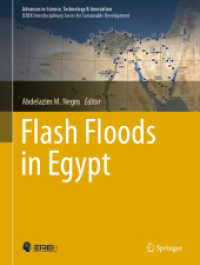- ホーム
- > 洋書
- > 英文書
- > Nature / Ecology
Full Description
A comprehensive account of the state of the science of environmental mass transport
Edited by Louis J. Thibodeaux and Donald Mackay, renowned experts in this field, the Handbook of Chemical Mass Transport in the Environment covers those processes which are critically important for assessing chemical fate, exposure, and risk. In a comprehensive and authoritative format, this unique handbook provides environmental chemists, geoscientists, engineers, and modelers with the essential capabilities to understand and quantify transport. In addition, it offers a one-stop resource on environmental mass transfer and mass transport coefficient estimation methods for all genres.
The book begins by discussing mass transport fundamentals from an environmental perspective. It introduces the concept of mobility — key to environmental fate, since transport must occur prior to any reaction or partitioning within the natural multimedia compartments. The fugacity approach to environmental mass transfer and the conventional approach are examined. This is followed by a description of the individual mass transport processes and the appropriate flux equations required for a quantitative expression. The editors have identified 41 individual processes believed to be the most environmentally significant, which form the basis for the remainder of the book
Using a consistent format for easy reference, each chapter:
Introduces the specific processes
Provides a detailed qualitative description
Presents key theoretical mathematical formulations
Describes field or laboratory measurements of transport parameters
Gives data tables and algorithms for numerical estimates
Offers a guide for users familiar with the process who are seeking a direct pathway to obtain the numerical coefficients
Presents computed example problems, case studies and/or exercises with worked-through solutions and answers
The final chapter presents the editors' insight into future needs and emerging priorities. Accessible and relevant to a broad range of science and engineering users, this volume captures the state of the transport science and practice in this critical area.
Contents
Introduction: Chemical Mobility in the Environment. Mass Transport Fundamentals from an Environmental Perspective. The Fugacity Approach to Mass Transport and MTCs. Flux Equations for Mass Transport Processes Across Interfaces. Estimating Molecular Diffusivities in Environmental Media. Deposition from the Atmosphere to Water and Soils with Aerosol Particles and Precipitation. Mass Transfer Between the Atmosphere and Plant Canopy Systems. Mass Transfer Within Surface Soils. Air-Water Mass Transfer Coefficients. Deposition and Resuspension of Particles and Associated Chemical Transport Across the Sediment-Water Interface. Advective Porewater Flux and Chemical Transport in Bed-Sediment. Diffusive Chemical Transport Across Water and Sediment Boundary Layers. Biotubation and Other Sorbed-Phase Transport Processes in Surface Soils and Sediments. Mass Transport from Soil to Plants. Dispersion and Mass Transfer in Groundwater Near-Surface Geological Formations. Dust Resuspension and Chemical Mass Transport from Soil to Atmosphere. Deposition of Dissolved and Particulate-Bound Chemicals from the Surface Ocean. Chemical Exchange Between Snow and the Atmosphere. Chemical Dynamics in Urban Areas. Mixing in the Atmosphere and Surface Waters with Application to Compartmental Box Models. Environmental Mass Transfer State-of-the-Art, Deficiencies, and Future Directions. Index.






